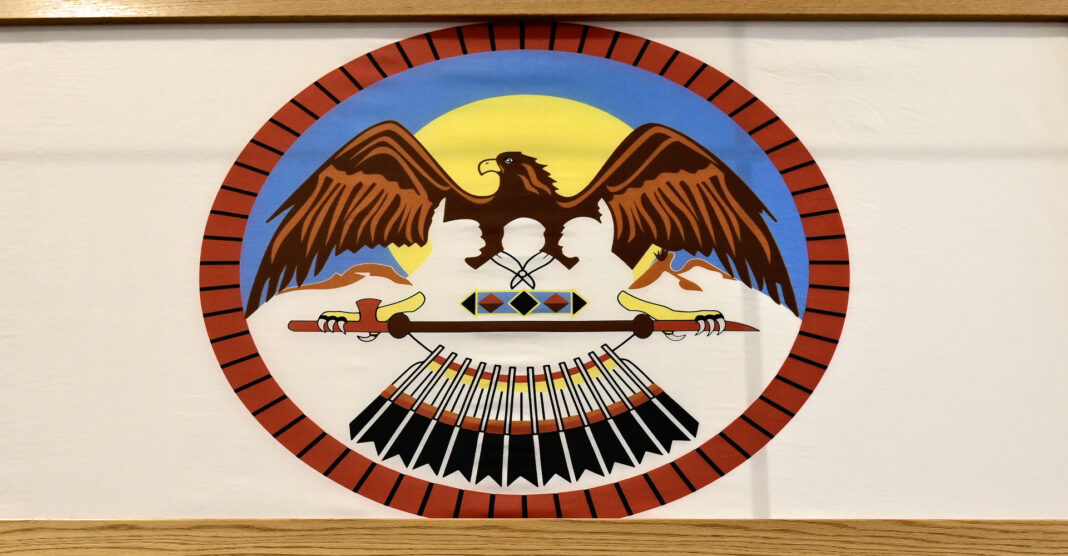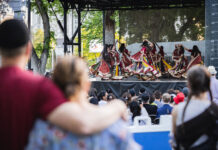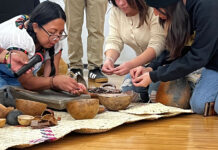
On the east end of Salt Lake Community College’s South City Campus, spanning a large section of the wall across from its multipurpose room, hangs an acknowledgement of several of the largest Native American tribes in Utah.
Eight flags suspended in polished wooden frames herald the emblems of eight different, sovereign Indigenous nations. A map of Utah is also hung on the wall beneath the ensigns. It sits behind a thin layer of protective glass and serves as a guide to the regions of Utah where each nation is from, as well as where they exist today.
Elsewhere at the Taylorsville Redwood Campus, directly east of the Student Center, an expertly designed rock formation juts up towards the sky. Atop one of the red boulders is a raised plaque, the same as that which hangs on the wall next to the map of the Utah nations in South City’s back hallway.
The two plaques are identical and cast in a weighty bronze.
“Salt Lake Community College is located on the Native American shared territory of the Goshute, Navajo, Paiute, Shoshone, and Ute People,” reads both plaques. “We honor the original ancestors of this land and also offer respect to our other tribal communities. We acknowledge this history to cultivate respect for and advocate with our Indigenous students and communities still connected to this land.”
Without Joseph Du Shane-Navanick, the plaques and their dedication wouldn’t exist. As part of his work in the college’s Office of Diversity of Multicultural Affairs (ODMA), Joseph was directly responsible for the installation of the two land acknowledgements in early 2022.
Joseph’s brother, Joey Du Shane-Navanick, has also held multiple vital positions within the ODMA, the college’s student association and the American Indian Student Leadership Club (AISL).
Together, the Navanick brothers work daily to ensure Native American heritage is recognized – and fostered – on SLCC campuses.
From reservation life to college and city life
Joseph and Joey are twin brothers from the Northern Ute tribal band of Utah. Their ancestors, however, hail from the White River Ute band. Many such bands, like the White River tribe, have been forcibly consolidated throughout years of colonialist expansion and government treaties.
The Uintah and Ouray Reservation where Joseph and Joey grew up covers much of the north-east region of Utah. It is an expansive piece of land, spanning over 4.5 million acres, which makes it the second largest reservation in the United States.
Unfortunately, the road from reservation life to college was anything but straightforward. Joey’s high school, for instance, did not adequately guide or prepare him for the competitive college application process.
“No one told me to do extracurricular activities. No one even told me that good grades were part of it. No one said, ‘Distinguish yourself, it’s a competition,’” Joey recalled.
Despite a rejection letter from the University of Utah, where he applied after graduating from Uintah High School in Vernal, Joey was determined to go to college. “There really wasn’t another option for me,” said Joey, who enrolled at SLCC after the rejection letter from the U. recommended he do so.
Together, the Navanick brothers moved from the rural and spacious Uintah and Ouray Reservation to the bustling, western-urban environment of Salt Lake City. They settled in an apartment near SLCC’s Taylorsville Redwood campus, and Joey started classes while Joseph worked as a mechanic.
Something in the homework Joey brought home one night especially piqued Joseph’s interest. At the time, Joey was taking foundations of business with Professor Ed Engh. Engh, as per the foundations of business curriculum, included a discussion of philosophy in the coursework for the class.
Joseph’s interest in business blossomed from then on, and he was soon enrolled at SLCC in the same program as Joey. But there were still adjustments to be made.
“The reservation life feels different,” Joseph said of the fish-out-of-water sensation that both brothers experienced when first attending classes at SLCC.
“I’m not treated as a foreign thing [on the reservation]. Immediately as you step off the reservation, you get tokenized, or you get treated like a mystical person,” Joseph said. “I’ve gotten comments like, ‘I thought Native Americans were extinct,’ or, ‘Do they really have reservations still?’”
Fortunately, the uncomfortable sensation that accompanied the brothers’ foray into college has faded somewhat with their involvement in the ODMA and AISL club.
‘Having diversity is the bare minimum’
When cultural differences clash, according to Joseph, it can be anxiety-inducing. Even the simplest of misunderstandings can make someone from a minority population feel uneasy, or worse, unwelcome.
For instance, even introducing oneself is done differently in Joseph and Joey’s Northern Ute upbringing. When meeting someone new, both brothers were taught to say their first name, followed by their family name, and finally, their relations (extended family).
“The thought is,” Joseph said, “You’re not only meeting me, but the people I represent.”
When meeting with other leaders at SLCC, Joseph and Joey felt out of place during introductions. The introduction style that others used differed greatly from how the brothers were taught in their culture. After some awkwardness, Joseph mustered up the courage to explain his introduction style to his colleagues in the meetings.
From his experience, Joseph has come to believe that cultural differences should always be acknowledged and embraced by those from the foremost culture, if only to diversify the viewpoints of those at the table.
“Having diversity is the bare minimum,” said Joseph. “I would like to see diversity along with resources and calls to action. It’s important to understand different cultures, their perspectives and what they [actually] need.”
Joseph and Joey’s work at the ODMA and AISL club helps to further integrate action-oriented diversity and cultural recognition everywhere from conference room tables to lunch tables and study hall desks.
Before graduating this Spring, Joseph was a specialist intern to the director of the ODMA, having been promoted to the position through the Campus Internship Program. As a specialist intern, one of Joseph’s responsibilities was to organize and teach lessons in an on-campus Brother-to-Brother (B2B) program.
As program facilitator for the ODMA’s B2B program, Joseph specifically targeted and preached positive masculinity. But he used his own culture when giving lessons, incorporating a traditional Indigenous concept called the “medicine wheel” into his teaching.
Medicine wheels are graphical symbols specific to Native American culture. They resemble pie graphs, but with each slice in equal proportion to the others. They are broken into four parts, and each part is coded with different colors.
The four parts of the medicine wheel, Joseph said, represent the mind, body, soul and the spirit of an individual. While the four “slices” are separate, they comprise a whole which is not conceptually distinct from its parts.
For his purposes, Joseph used the medicine wheel to teach positive masculinity.
“It helps me teach what I’ve learned from my culture in a symbol that people will understand,” Joseph explained. “There’s different parts to the medicine wheel, but it’s a whole thing, so it helps me teach wholeness, spirituality, as well as a person’s place in the world.”
Before earning his SLCC cap and gown, Joseph was also president of the AISL club, where Joey remains vice president. The AISL club is a branch of the ODMA office which fosters community and achievement among Native students at SLCC. Though it had been closed when the brothers started at SLCC, they re-founded it just under two years ago.
Now open to all, the AISL club is a place where Indigenous students and faculty can discuss their different cultures and heritages. Helmed by Joseph and Joey, the AISL club also educates the surrounding college and community of the presence of Indigenous peoples in Salt Lake.
Winter Rex, who works with the Navanick brothers as student success coordinator for Native American students at the ODMA, and faculty advisor for the AISL club, said the club’s very existence helps native students know there is a community for them at SLCC.
“When people think of Native Americans, a lot of people think of the past or think we’re not here anymore. But we are, and we’re normal people too,” Rex said.
The AISL club has weekly meetings which are open to everyone. They also host several annual events and activities, such as the annual Round Dance in November, which is Native American heritage month.
Diversity through respect and education builds a future for all
If one visits the Native land acknowledgements at either South City or Taylorsville Redwood in the future, they may notice the verbiage on the bronze plaques change. This is because Rex, along with Joseph and Joey, are petitioning to have it updated.
Land acknowledgement, according to Rex, has caught steam lately, both as a concept and as a trend. However, it is not enough, she says, to simply read or hear once that SLCC sits on native land.
“No matter where you’re at, you’re always on someone’s traditional territory,” Rex said. “To me, land acknowledgement means that you always know that you are on traditional territory. It’s in your everyday knowledge.”

Winter compared this type of understanding to a math formula that isn’t forgotten after the next test but built upon with further knowledge.
Rex also stressed that land acknowledgement should include a study of history. By seeking to understand the persecution, exile and genocide that Native Americans have experienced in this country, she says that one is able to gain a fuller picture of Native issues now.
When Joseph and Joey graduate with business degrees, they plan to “create a pipeline for kids who want to come off the reservation and … help them holistically, whether that’s transferring to a college or a technical school, or something else entirely,” Joey explained.
“And [we also want to help them] with just making that transitional move from reservation life to city life,” Joey continued. “Because it isn’t easy – it’s a culture shock.”














